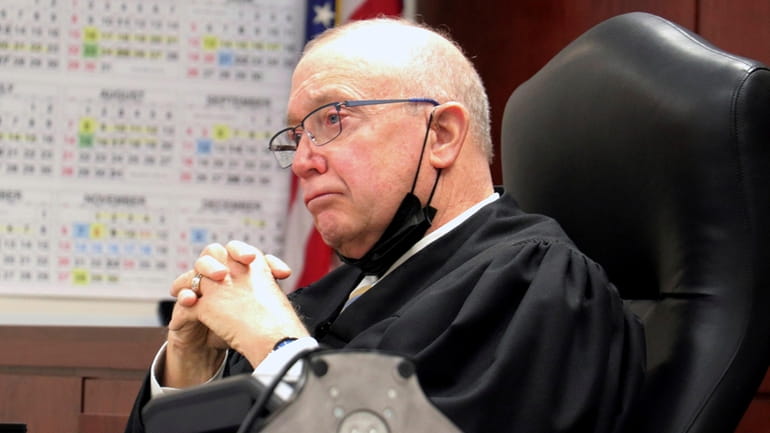New redistricting maps aid GOP, make some districts more competitive

Judge Patrick McAllister listens to arguments during a hearing in court on March, 31 in Bath, N.Y. Credit: AP/Vaughn Golden
A state court has approved New York’s new congressional and State Senate maps, boosting Republicans’ chances in a host of areas, making some districts more competitive and sparking a flurry of campaign jockeying for seats.
State Supreme Court Justice Patrick McAllister of Steuben County approved the maps around midnight Friday, formally replacing Democratic-drawn maps that the state’s highest court deemed illegally gerrymandered.
The new maps were drawn by Jonathan Cervas, the court-appointed mapmaker and redistricting analyst, and set district boundaries for the state’s congressional districts and State Senate for the next decade, barring any lawsuits.
In Congress, the new map boost Republicans’ chances of winning more seats in the state and creates more “swing” districts.
For example, the map that was declared unconstitutional had created 22 Democratic-leaning districts and four Republican. The new one technically features a 21-5 split but five of the Democratic-leaning districts could be considered toss-ups, giving the GOP the prospect of emerging with 10 seats.
“So, New York ends up with a 21-5 Biden map. Not the worst outcome for Dems,” said Dave Wasserman, a redistricting analyst with the Cook Political Report, wrote on Twitter. “But because five of those seats are single-digit Biden seats, anything from 16D-10R to 21D-5R realistic depending on the year.”
Judge McAllister, in a note accompanying the maps, declared them “perfectly neutral,” saying it created 15 Democratic districts, three Republican and eight toss-ups.
New York’s current delegation includes 19 Democrats and eight Republicans, but the state is losing a seat because it hasn’t kept pace with the population growth of other states. The new map basically eliminates an upstate seat — which saw population losses — and moves many districts north and west to absorb it.
“In Congress, I think the Republican position was improved — there’s no question about that,” said Jay Jacobs, the state and Nassau County Democratic chairman, on Saturday. “But I’m pretty sure as we move forward into the fall, we’re going to have successes in places that aren’t apparent now.”
Cervas had unveiled a draft proposal Monday but clearly made changes before finalizing it in response to Democratic complaints. For example, he reunited Bedford-Stuyvesant and Crown Heights in Brooklyn in one district.
In the State Senate, the changes were subtler in terms of overall balance but will force a number of candidates to shift districts to run in their preferred seats, especially on Long Island. And in the case of the 2nd Senate District, it sets up a matchup of two incumbents, Sen. Mario Mattera (R-St. James) versus Sen. Jim Gaughran (D-Northport) because the district was shifted west to include parts of Huntington.
A Gaughran aide told Newsday the Democrat is running in the 2nd just minutes after Jacobs said it was “unwinnable” and called Gaughran the “odd person out” in the redistricting shuffle.
Importantly, the new map creates two new “minority majority” districts on the Island — where whites no longer account for more than 50% of the population. But it simultaneously created two clearly strong GOP districts based in Suffolk County and made discreet changes that will give Republicans a shot in others — such as removing Elmont and Westbury from the 7th Senate District, currently held by Sen. Anna Kaplan (D-North Hills).
“I think any districts we’re getting are better than the gerrymandered districts” tossed out by the courts, said Suffolk County GOP Chairman Jesse Garcia. “The results are very good for the people of Suffolk County and they provide better competitive balance.”
Here’s what to know about the key changes for Long Island and elsewhere:
CONGRESS
The 1st Congressional District, currently held by Republican Rep. Lee Zeldin, who is running for governor, loses a large chunk of its South Shore and extends farther along the North Shore, all the way to Lloyd Harbor. By including much of Huntington, it now is a slightly (50%-49%) Democratic-leaning district.
The 2nd District, held by Rep. Andrew Garbarino (R-Bayport), will remain a South Shore one, but becomes slightly more competitive by losing Massapequa Park and other parts of Nassau County. It’s now 51%-49% Republican.
The 3rd District loses the North Shore of Suffolk County and instead moves south to parts of Massapequa, though it still favors Democrats, 54%-46%. But what’s most notable is the final map scuttled a Democratic plan to make this a “Sound Shore District,” running from Suffolk, ringing the Long Island Sound and going all the way through Westchester County.
The 4th District remains Democratic but becomes more compact by losing Westbury and Mineola.
In Manhattan, the new map creates a Democratic primary in the 12th between longtime Reps. Jerry Nadler and Carolyn Maloney. It created an open seat for the 10th in lower Manhattan.
In Brooklyn, Rep. Mondaire Jones said he’d forgo his lower Hudson Valley district to run here, setting up a possible primary against former New York Mayor Bill de Blasio. Jones, one of the first openly gay Black members of Congress, said he’s running in the new district because it was the “birthplace of the LGBTQ+ rights movement.”
STATE SENATE
Of the Island’s nine Senate districts, the clearly Republican districts are the 3rd and 8th. Sen. Alexis Weik (R-Sayville) had previously announced for the 4th but will run in the 8th, which runs along the ocean from Sayville to Massapequa. Former Assemb. Dean Murray of East Patchogue will run in the 3rd.
The clearly Democratic ones are the 4th and 6th, which requires some candidate shifting. Monica Martinez of Brentwood, who had said in February she’d run for the 3rd now will run for the 4th, which favors Democrats, 62%-38% Jacobs said. Hispanics, at 40%, now make up a plurality of the district.
Sen. Kevin Thomas (D-Levittown) will run again in the 6th District, even though, under the new map, his home landed in the 5th, Jacobs said. That will avoid a primary with Sen. John Brooks (D-Seaford) in the 5th. Further, the 6th is 68% Democratic and, by adding Freeport and Westbury, is now a majority-minority district.
Gaughran has been representing the 5th District but resides in what is now part of the 2nd. The somewhat good news for him is the 2nd District is less north-south oriented and more east-west, running all the way to Lloyd Harbor and becoming 50% Republican instead of 53%.
Democrats need a new candidate in the 9th District, Jacobs said. The district is located in the southwest corner of Nassau and is held by Sen. Todd Kaminsky, who isn’t running for reelection. The new boundaries run more north-south — up to Floral Park. The Democrats’ previously announced candidate, Michael Pernick, lives outside the boundaries and a move isn’t feasible at this time, Jacobs said. So the party is starting over.

